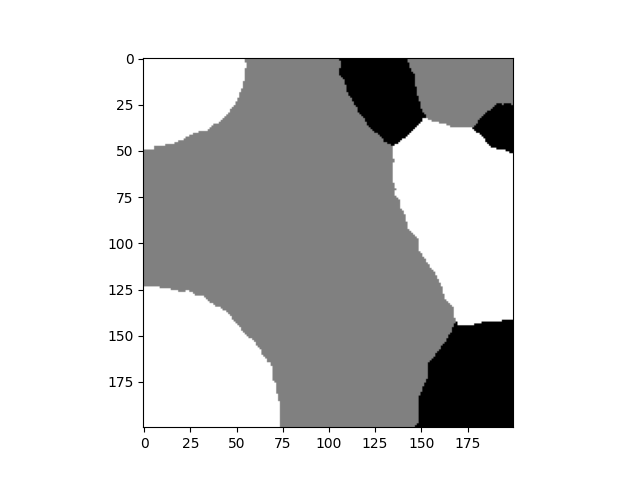In this tutorial, we will explore the jax.extend.ffi module, with a tutorial available here. Specifically, we will adapt this module to use a naive Gibbs sampler algorithm written in C++ from JAX.
We have a small C++ library that implements a naive version of the Gibbs sampler. The three functions it offers are available in lib/gibbs_sampler.h:
void initialize(int* image, int rows, int cols, int Q);
void printImage(int* image, int rows, int cols);
void RunGibbsSampler(int* image, int rows, int cols, int Q, float beta, int iter);The file gibbs_sampler_cpp.cpp times this implementation of the Gibbs sampler for
// Thanks chatgpt for the quick gibbs sampler implementation
#include <iostream>
#include <cmath>
#include <cstdlib>
#include <ctime>
#include <chrono>
#include "lib/gibbs_sampler.h"
using namespace std;
using namespace std::chrono; // Use the chrono namespace
// Main function
int main() {
int rows = 200;
int cols = 200;
int Q = 3; // Number of possible labels (states)
float beta = 1.0; // Coupling strength
int iter = 1000;
// Allocate memory for the image
int* image = new int[rows * cols];
auto start = high_resolution_clock::now();
// Initialize the image with random states
initialize(image, rows, cols, Q);
// cout << "Initial image:" << endl;
// printImage(image, rows, cols);
RunGibbsSampler(image, rows, cols, Q, beta, iter);
auto stop = high_resolution_clock::now();
auto duration = duration_cast<milliseconds>(stop - start);
cout << "Execution time: " << duration.count() << " milliseconds" << endl;
// cout << "Final image after Gibbs sampling:" << endl;
// printImage(image, rows, cols);
// Free allocated memory
delete[] image;
return 0;
}The above file is compiled and executed with the command:
bazel build main && bazel-bin/mainThe build main instruction is found in BUILD.bazel (this is a simple executable cc_binary compilation):
cc_binary( # no header here, we are not building a library
name = "main",
srcs = ["gibbs_sampler_cpp.cpp"],
visibility = ["//visibility:public"],
deps = ["//lib:gibbs_sampler_lib"]
)However, this build rule depends on another build rule, which is for the Gibbs sampler library gibbs_sampler_lib. This rule, executed automatically by dependency, is located in lib/BUILD.bazel:
cc_library(
name = "gibbs_sampler_lib",
srcs = ["gibbs_sampler.cpp"],
hdrs = [
"gibbs_sampler.h", # These headers are intended to be included by other libraries or binaries that depend on this library.
],
copts = ["-std=c++17"],
visibility = ["//visibility:public"],
)Finally, running the program gives:
Execution time: 3718 millisecondsLet's keep this value in mind as a reference for later. Also, note the illustration (see the git repository for the C++ code that includes saving the image):
As indicated in the two available tutorials on the subject (in the JAX documentation and the XLA documentation), we will need to wrap the functions of our library in the XLA custom call API.
We start by downloading the API in three files, api.h, c_api.h, and ffi.h, which we place in lib/xla/ffi/api/. We then create a function GibbsSamplerImpl that will wrap initialize and RunGibbsSampler available in gibbs_sampler.h. This wrapping is done using specific objects: Buffer (representing jax.numpy arrays), Datatype, Error, Bind, and Attr. These objects act as intermediaries between the jax.numpy data structures and C++. Their usage is described in the tutorials mentioned above.
Interestingly, GibbsSamplerImpl does not take an array (jnp.array) as input, i.e., no Bind.Arg<>(); the only input arguments are named attributes, i.e., Bind().Attr<>(). However, there will be a return, which will be the resulting sampler array, i.e., Bind().Ret<>(). Finally, the actual function of interest that can be used via the jax.extend module is constructed by the XLA_FFI_DEFINE_HANDLER_SYMBOL macro and will be called GibbsSampler.
All these operations are written in
lib/gibbs_sampler_xla.cpp:
#include <cmath>
#include <cstdint>
#include <numeric>
#include <type_traits>
#include <utility>
#include <functional>
#include "xla/ffi/api/c_api.h"
#include "xla/ffi/api/ffi.h"
extern void initialize(int* image, int rows, int cols, int Q);
extern void RunGibbsSampler(int* image, int rows, int cols, int Q, float beta, int iter);
namespace ffi = xla::ffi;
ffi::Error GibbsSamplerImpl(
//ffi::BufferR1<ffi::DataType::S32> in_img,
ffi::Result<ffi::BufferR2<ffi::DataType::S32>> img,
int rows,
int cols,
int Q,
float beta,
int iter
) {
initialize(img->typed_data(), rows, cols, Q);
RunGibbsSampler(img->typed_data(), rows, cols, Q, beta, iter);
return ffi::Error::Success();
}
XLA_FFI_DEFINE_HANDLER_SYMBOL(
GibbsSampler, GibbsSamplerImpl,
ffi::Ffi::Bind()
// .Arg<ffi::BufferR1<ffi::DataType::S32>>()
.Ret<ffi::BufferR2<ffi::DataType::S32>>()
.Attr<int>("rows")
.Attr<int>("cols")
.Attr<int>("Q")
.Attr<float>("beta")
.Attr<int>("iter")
);To simplify the code, wrapping the gibbs_sampler.h library using the XLA API constitutes an intermediate library whose header is gibbs_sampler_xla.h. We compile it with the gibbs_sampler_xla_lib rule defined in lib/BUILD.bazel
cc_library(
name = "gibbs_sampler_xla_lib",
srcs = [
"xla/ffi/api/c_api.h",
"xla/ffi/api/ffi.h",
"xla/ffi/api/api.h",
"gibbs_sampler_xla.cpp",
], # When deciding whether to put a header into hdrs or srcs, you should ask whether you want consumers of this library to be able to directly include it
hdrs = [
"gibbs_sampler_xla.h",
],
includes = [ # need to use include -I option is not available due to sandbox stuff
".", # adding to srcs or hdrs does not include
],
copts = ["-std=c++17 -rdynamic"], # -rdynamic to use extern
deps = ["//lib:gibbs_sampler_lib"],
visibility = ["//visibility:public"],
)Note that this rule requires the execution of the gibbs_sampler_lib rule.
As in the C++ from Python tutorial, we will use pybind and PyCapsule for this part of the operations. We will create a Python module called gibbs_sampler, which will contain a function also called gibbs_sampler. Calling this function will return a PyCapsule containing the GibbsSampler function defined at the end of the previous section. The code that accomplishes this is in lib/gibbs_sampler_xla_pybind.cc.
#include <pybind11/pybind11.h>
#include "gibbs_sampler_xla.h"
template <typename T>
pybind11::capsule EncapsulateFunction(T* fn) {
return pybind11::capsule(reinterpret_cast<void*>(fn));
}
PYBIND11_MODULE(gibbs_sampler, m) { // please match the pybind_extension target name
m.def("gibbs_sampler", []() { return EncapsulateFunction(GibbsSampler); });
}The code is compiled into a Python module with the gibbs_sampler rule defined in lib/BUILD.bazel:
pybind_extension( # must be in two steps (first cc_library then pybind_extension)
name = "gibbs_sampler", # must match the pybind module name
srcs = ["gibbs_sampler_xla_pybind.cc"],
deps = ["//lib:gibbs_sampler_xla_lib"],
copts = ["-std=c++17 -rdynamic"]
)Note the dependency on the gibbs_sampler_xla_lib rule.
Finally, the Python module can be compiled with the simple command:
bazel build //lib:gibbs_samplerWe are finally able to use the C++ function from JAX!
In the file gibbs_sampler_c_from_JAX.py:
- We register our FFI call (name, PyCapsule, platform):
jex.ffi.register_ffi_target("gibbs_sampler", gibbs_sampler_lib.gibbs_sampler(), platform="cpu")-
We define a Python function
gibbs_sampler_cppthat makes the call toGibbsSampler, the function hidden in the PyCapsule, usingjax.ffi.ffi_call. Note that this call is now quite simple. We need to specify the dimensions and type of the returned result with ajax.ShapeDtypeStructobject, and we do not need to specify input arguments since we only have attributes passed as keyword arguments. -
We perform the call with the same parameters as before and time it:
rows = 200
cols = 200
Q = 3
beta = 1
n_iter = 1000
start = time.time()
res = gibbs_sampler_cpp(rows, cols, Q, beta, n_iter)
end = time.time()
print(f"Time: {end - start} seconds")Running this script gives:
Time: 3.9689433574676514 secondsThis is a time slightly higher than calling the same function directly from C++ with the same parameters. Thus, we achieve the expected result in terms of time, as well as in the illustration:
The JAX library in Python offers the key feature of Just-In-Time (JIT) compilation, which allows for the compilation of Python code at the first execution for much faster subsequent executions, generally.
The mrfx library provides a pure JAX implementation of the Gibbs sampler and the chromatic Gibbs sampler. We can obtain timing for the Gibbs sampler using the code in the file gibbs_sampler_JAX_cpu.py:
import os
os.environ["JAX_PLATFORMS"] = "cpu"
import time
import jax
key = jax.random.PRNGKey(0)
from mrfx.models import Potts
from mrfx.samplers import GibbsSampler
from mrfx.experiments import time_complete_sampling
rows = 200
cols = 200
Q = 3
beta = 1
n_iter = 1000
key, subkey = jax.random.split(key, 2)
times, n_iterations = time_complete_sampling(
GibbsSampler,
Potts,
subkey,
[Q],
[(rows, cols)],
5,
kwargs_sampler={"eps": 0.01, "max_iter":n_iter, "cv_type":"iter_only"},
kwargs_model={"beta":1.}
)
print("JAX on CPU", times)We note a displayed compilation + execution time of
The file gibbs_sampler_JAX_gpu.py allows for running the previous code on a GPU. However, it appears that the algorithm is about 10 times slower in both compilation and execution. This is likely due to the highly iterative nature of the algorithm, which is not well-suited to a GPU architecture...
We have successfully called C++ code from JAX. We can conclude that for this highly iterative Gibbs sampling algorithm, JAX's Just-In-Time compilation does not surpass a direct call to C++ code. The advantage of using jax.extend.ffi here is significant.

